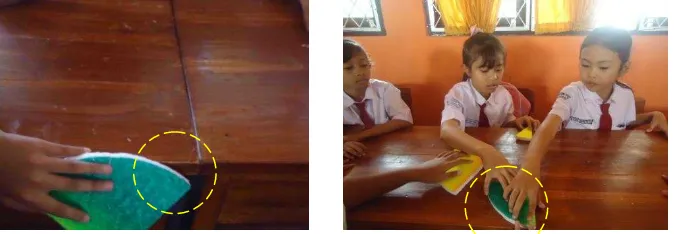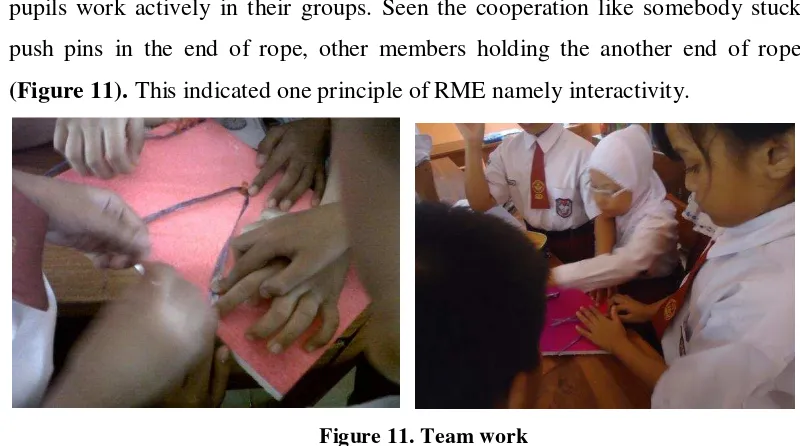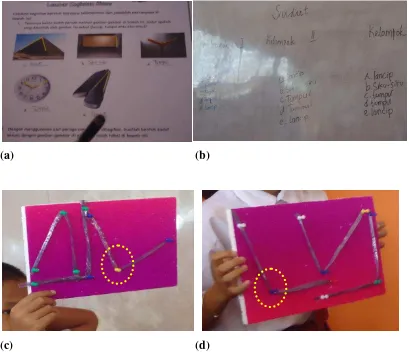First Instructional Design of RME:” Teaching of Angle Comparison by Using Styrofoam and Ropes for Grade 4 of SDN 179“
Achmad Dhany Fachrudin1 Ummy Salmah2, dan Sitti Busyrah3
International Master Program on Mathematics Education (IMPoME 2012)
email: [email protected], [email protected], [email protected]
I. Introduction
“Mathematics is a human activity” is considered to be a familiar statement expressed by Hans Freudenthal. Through this statement, Freudenthal wanted to show that Mathematics is not a product which teacher can give to the pupils directly, but as a form of activity in constructing mathematical concept (Wijaya, 2008). This statement is also a base of development of Realistic Mathematics Education (RME), a mathematical learning approach which comes from The Netherland. Nowadays RME is also developing in Indonesia namely Indonesia Realistic Mathematics Education (IRME). Teaching and learning process in RME emphasize the importance of meaningful concept in mathematics for pupils. It is also supported by another Freudenthal statement which is teaching and learning happen only if it is meaningful for the pupils.(Wijaya, 2008). Therefore, to make conceptual understanding of pupils, teacher should make the condition of meaningful learning that can be reached by using IRME approach. This underlies us to make a design of teaching and learning in elementary school using IRME approach.
The material chosen by researchers in developing the design of teaching and learning at the time is measurement, with sub material angel measurement. Here, researchers try to use “senam tangan” and tool media that made of ropes and styrofoam to bridge between the informal and formal knowledge of pupils in the material of angle.
II. Designing Instructional
The material analysed was knowing and comparing angle for pupils in grade 4 SDN 179 Palembang. This was conducted for designing learning of knowing and comparing angle that would be taught using “senam tangan” activity and tool media which was developed by the researchers and teacher.
1. Preliminary Design: design the instructional scenario by researcher team and the teacher.
At this stage, the research team analysed the curriculum related to material that would be reviewed, which is the measurement angle, formulated learning goals and learning indicators, defined the context of the approach used and designed learning activities that was going to be carried out.
Based on analysis of the curriculum, comparing angles is material taught in grade fourth semester 1 with the competency standards is use measurement of angle, length and weight in problem solving and basic competence is to determine the angle by non-standard units and degrees units. Based on the internal discussions (teachers not involved) had been done, learning indicators chosen by the researchers is knowing the angle, comparing between two angles and measuring angles with standard and non-standard units for once meeting. Furthermore, the researchers determined the context used in instructional design and prepared a preliminary design of learning tools that would be used, such as worksheets, lesson plans, and tool media. Researchers use the Styrofoam boards, ropes and pins as tool media to make an angel.
On October 30, 2012, the researchers met the teacher (Mrs Intan) to discuss the initial learning tools already prepared. Further, after discussing, we got some advice from the tacher. First, we should reduce the learning indicators became knowing the angles and comparing between two angle only. Secondly, the addition of the context used in the teaching and learning process. The last was we should add the tool media used, that is the examples of sectors that have different angle sizes.
design of learning should be implemented in the classroom. Implementation of lesson plan and analysis of pupil work will be described in the section „teaching experiments'.
2. Teaching Experiment
Picture 2.Pupils seemed enthusiastic in putting the model of angles
to the corner of their table.
We continue the activity to compare the angle.Pupils still used the same models of angle. At that time, teacher asked every group to heaped their models of angle, from the biggest one (obtuse angle), right angle, to acute angle. They seemed enthusiastic doing this activity. Some of them snatched away to make the heap. After heaping the model of angles, the pupils were guided to compare those angles. Now, they could know and differentiate obtuse angle, right angle, and acute angle.
Picture 3.Heap of angle models which was arranged by pupils
Picture 4.Pupils formed angles by using their hands
The next activity was important to make pupils understand more about those three angles (obtuse, right, and acute angles). It is called Senam Tangan. Teacher asked them to stand up and close their eyes. They have to make angle by using their hands according to teacher‟s instruction. Some of them were confused and made many mistakes during this activity. It happened when teacher instructed them faster. However, they look very enthusiastic to do this activity. Sometimes they laughed when they made a mistake. Instruction was done many times until the pupils could differentiate those three angles.
Picture 5.Pupils formed angles by using their hands
Picture 6.Pupils was doing their worksheets
Picture 7.Pupils presented their discussion results
After finishing doing their worksheet, they continued to present their discussion results in front of the class. Every group was asked to write their answers in whiteboard. Two of members in every group were asked to present their answer and discussion results. The last activity was doing the exercise in mathematics book individually.
3. Retrospective Analysis
Retrospective analysis was done by teacher and researchers after teaching and learning process had finished, while pupils were not involved in this process. It was done to reflect and analyze the learning process and to discuss the problems or some obstacles occurred during the learning process. Besides that, this activity is important to know the way of pupil‟s thinking by analyzing their works and answers.
Actually, learning process ran and teacher could guide pupils well. During discussing with their groups, the pupils seemed so active and enthusiastic. However, most of them have not understood the concept of angle which they learnt in Grade 3 that angle is the intersection of two straight lines. They had wrong answers when they were asked to show the angle in the media which was given and when they put the model of angle to the corner of the table (Figure 9).
Figure 9. Pupils’ mistakes in laying angle form on table corner.
(a) (b)
Figure 10. Senam tangan activity
Next, on the forming an angle with use raffia and push pins on Styrofoam, pupils work actively in their groups. Seen the cooperation like somebody stuck push pins in the end of rope, other members holding the another end of rope
(Figure 11). This indicated one principle of RME namely interactivity.
Figure 11. Team work
Overall pupils did not have difficulties in determining the angle of several objects exerted on number one in the worksheet (Figure 12a and 12b). Also, they formed vary of acute angle, right-angle, and obtuse angle. However, Group 4 was less scrupulous so there was a mistake in an obtuse angle which they form
discussed by researchers team and the teacher then we concluded that pupil sometimes confusion determine an angle when it is rotated.
(a) (b)
(c) (d)
Figure 11. Pupils’ answers (Figure (a) and (b) pupils’ answer in determining angle of
several objects, figure (c) Pupils less scrupulous form an obtuse angle, figure (d) correct
answer)
Figure 12. Pupils’ answer about definition of right, acute, and obtuse angle.
III. Conclusion
Based on the description above, note that having regard to the objects around us like the end of the table, propeller fan, and clockwork, pupils have informally learned about angles. By using ropes (raffia) pupils can form an angle as the angle on the objects and then compare them to find the concept of difference of a right, acute and obtuse angle.
In this study the characteristics of PMRI were the use of the context (the angle of objects such as propeller fan, clockwise); the use of model (Styrofoam, raffia rope, push pins); pupils‟ contribution and construction (determines the shape and angle); interactivity (presentation, teamwork); intertwining (measurement, comparison).
REFERENCE


